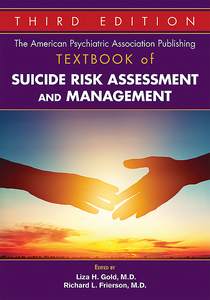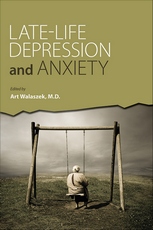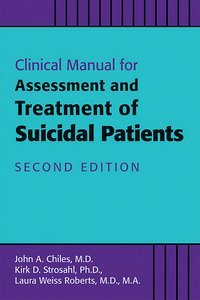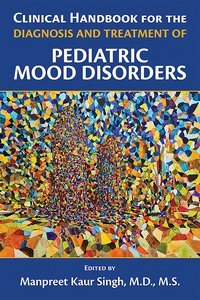The American Psychiatric Association Publishing Textbook of Suicide Risk Assessment and Management, Third Edition
View Pricing
Description
Charged with updating the preeminent text on suicide, the new editors of The American Psychiatric Association Publishing Textbook of Suicide Risk Assessment and Management opted not to simply revise existing chapters, but instead to steer a bold course, expanding, reconfiguring, and remaking the third edition to reflect the latest research, nomenclature, and clinical innovations. The editorial team and contributors—two-thirds of whom are new to this edition—have taken the intersection of suicide with both mental health and psychosocial issues as their organizing principle, exploring risk assessment and epidemiology in special populations, such as elderly patients, college students, military personnel, and the incarcerated as well as patients with a variety of psychological disorders, including bipolar spectrum, personality, depressive, anxiety, posttraumatic stress, and other disorders and schizophrenia. In addition, the book discusses treatment options (such as cognitive-behavioral therapy, dialectical behavioral therapy, and pharmacotherapy) and settings (such as emergency services, outpatient, inpatient, and civil commitment) in detail, with clinical cases to contextualize the material.
The new and revised content is extensive:
- A chapter on the influence of sleep and sleep disorders on suicide risk has been included that considers possible mechanisms for this link and discusses practical ways of assessing and managing sleep disorders to mitigate suicide risk.
- Nonsuicidal self-injury, the prevalence of which is particularly high among youth, is addressed in detail, differentiating it from and comparing it to suicide attempts, discussing risk assessment, considering safety interventions, examining treatment options, and exploring suicide contagion.
- No text on suicide would be complete without a serious exploration of the role of social media and the internet. The book presents an update on current research as it pertains to social networking and behavior, information access, and artificial intelligence and software, and includes suggestions for clinicians treating patients at risk for suicide.
- Physician-assisted dying (PAD), also referred to as aid-in-dying, is arguably a form of suicide, and the book includes a thoughtful chapter considering the ethical and practical implications of PAD, the murky professional and legal obligations that may arise, the demographics of these patients, the settings and conditions under which PAD may occur, and the role of the attendant clinicians.
- A number of pedagogical features are included to help the reader learn and remember the material, including key clinical concepts and abundant case examples.
Its diverse range of perspectives, broad relevance to a wide variety of clinicians, and absolutely authoritative coverage makes this new edition of The American Psychiatric Association Publishing Textbook of Suicide Risk Assessment and Management a worthy and indispensable successor.
Contents
Part I. Suicide Risk Assessment and Treatment
- Chapter 1. Suicide Risk Assessment
- Chapter 2. Pharmacotherapy and Neuromodulation
- Chapter 3. Cognitive and Behavioral Therapy
- Chapter 4. Psychodynamic Treatment
- Chapter 5. Split Treatment: The Psychiatrist's Role
- Chapter 6. Cultural Humility and Structural Competence in Suicide Risk Assessment
Part II. Major Mental Disorders
- Chapter 7. Depressive Disorders
- Chapter 8. Anxiety Disorders, Obsessive-Compulsive Disorder, and Posttraumatic Stress Disorder
- Chapter 9. Substance-Related Disorders
- Chapter 10. Bipolar Spectrum Disorders
- Chapter 11. Schizophrenia and Other Psychotic Disorders
- Chapter 12. Personality Disorders
- Chapter 13. Sleep and Suicide
Part III. Treatment Settings
- Chapter 14. Emergency Services
- Chapter 15. Outpatient Treatment of the Suicidal Patient
- Chapter 16. Inpatient Treatment
- Chapter 17. Civil Commitment
Part IV. Special Populations
- Chapter 18. Children and Adolescents
- Chapter 19. College and University Students
- Chapter 20. Suicide in the Elderly Population
- Chapter 21. Jails and Prisons
- Chapter 22. Military Personnel and Veterans
- Chapter 23. Suicide and Gender
- Chapter 24. Self-Injurious Behavior
Part V. Special Topics
- Chapter 25. Social Media and the Internet
- Chapter 26. Physician-Assisted Dying
- Chapter 27. Suicide Risk Management: Mitigating Professional Liability
- Chapter 28. The Psychological Autopsy and Retrospective Evaluation of Suicidal Intent
Part VI. Prevention
- Chapter 29. Suicide and Firearms
- Chapter 30. Suicide Prevention Programs
- Chapter 31. Teaching Suicide Risk Assessment in Psychiatric Residency Training
Part VII. Aftermath of Suicide
- Chapter 32. Psychiatrist Reactions to Patient Suicide and the Clinician's Role
- Index
Contributors
- Abby Adler, Ph.D.
Peter Ash, M.D.
Claudia Avina, Ph.D.
Alaina Baker, B.S.
Richard Balon, M.D.
Michele Berk, Ph.D.
Kimberly Brandt, D.O.
Beth S. Brodsky, Ph.D.
Juan Jose Carballo, M.D.
Stephanie Clarke, Ph.D.
Victoria Cosgrove, Ph.D.
Katrina DeBonis, M.D.
Nathan Fairman, M.D., M.P.H.
Antonio Fernando, M.D., ABPN
Susan Hatters Friedman, M.D.
Richard L. Frierson, M.D.
Rachel Funk-Lawler, Ph.D.
Glen O. Gabbard, M.D.
Michael Gitlin, M.D.
Liza H. Gold, M.D.
Derrick A. Hamaoka, M.D.
Annette Hanson, M.D.
Lindsay M. Hayes, M.S.
Ryan Holliday, Ph.D.
Poh Choo How, M.D., Ph.D.
Pamela Howard, M.D., M.B.A.
Ashley Blackmon Jones, M.D.
Kaustubh G. Joshi, M.D.
Anita S. Kablinger, M.D., CPI, FAAP, FAPA, FACRP
Kieran Kennedy, M.B.Ch.B., B.Sc.
Christine Kho, M.D.
Nicole Kramer, M.S.
John Lauriello, M.D.
Benjamin Liu, M.D.
Dexter Louie, M.D.
Jeffrey L. Metzner, M.D.
Lindsey L. Monteith, Ph.D.
Sarra Nazem, Ph.D.
Maria A. Oquendo, M.D.
Britta Klara Ostermeyer, M.D., M.B.A., FAPA
Paula Padierna, M.D.
Rebecca A. Payne, M.D.
Jedidiah Perdue, M.D., M.P.H.
Marilyn Price, M.D.
Divy Ravindranath, M.D., M.S., FACLP
Patricia R. Recupero, J.D., M.D.
Phillip Resnick, M.D.
Elspeth Cameron Ritchie, M.D., M.P.H.
Ayal Schaffer, M.D.
Lindsey Schrimpf, M.D.
Charles L. Scott, M.D.
Andreea L. Seritan, M.D.
Ruth Shim, M.D., M.P.H.
Navneet Sidhu, M.D.
Barbara Stanley, Ph.D.
Katherine A. Straznickas, Ph.D.
Trisha Suppes, M.D., Ph.D.
Robert L. Trestman Ph.D., M.D.
Robert J. Ursano, M.D.
Donna Vanderpool, M.B.A., J.D.
Amy Wenzel, Ph.D., ABPP
James C. West, M.D.
Cheryl D. Wills, M.D.
Hal S. Wortzel, M.D.
Brian W. Writer, D.O.
Peter Yellowlees, M.B.B.S., M.D.
About the Authors
Liza H. Gold, M.D., is a Clinical Professor of Psychiatry at Georgetown University School of Medicine in Washington, D.C.
Richard L. Frierson, M.D. is Vice Chair for Education and Alexander G. Donald Professor in the Department of Neuropsychiatry and Behavioral Science at University of South Carolina School of Medicine in Columbia, South Carolina.
Related Products
Carousel Control - items will scroll by tabbing through them, otherwise arrows can be used to scroll one item at a time








